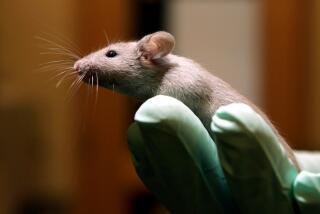Rodent of the Week: Regaining muscle via stem-cell transplant
- Share via
A specific type of stem cells transplanted into the leg muscles of injured young mice not only repaired the muscle damage but triggered changes in the muscle tissue that made it resistant to normal aging.
The surprising finding, which was published Wednesday in Science Translational Medicine suggests that, under the proper conditions, stem cells might regenerate muscle tissue.
Researchers led by Bradley Olwin of the University of Colorado, Boulder, took stem cells from the muscles of young donor mice and transplanted them into mice with muscle injuries. Stem cells are unique because of their ability to renew themselves through cell division and differentiate into specific cell types. In this case, the transplanted cells took over in the host muscle and not only repaired the injured muscle, which was expected, but permanently altered the muscle tissue so that it retained its mass and strength for the lifetime of the mouse.
“The transplanted material seemed to kick the stem cells to a high gear for self-renewal, essentially taking over the production of muscle cells,” Olwin said in a news release. “We expected the cells to go in, repopulate and repair damaged muscle and to dissipate. It was quite surprising when they did not.”
The study showd that when stem cells were transplated into healthy mouse limbs, there were no changes in muscle growth. Moreover, the authors noted, the donor cells came from young mice and were transplanted into young muscle. So it appears the environment the stem cells are injected into is crucial to how they respond.
The research will continue to see if injections of human stem cells into mice will have the same effect. If successful, the research could lead to treatments to help people with degenerative muscle disorders.
Return to Booster Shots blog.





